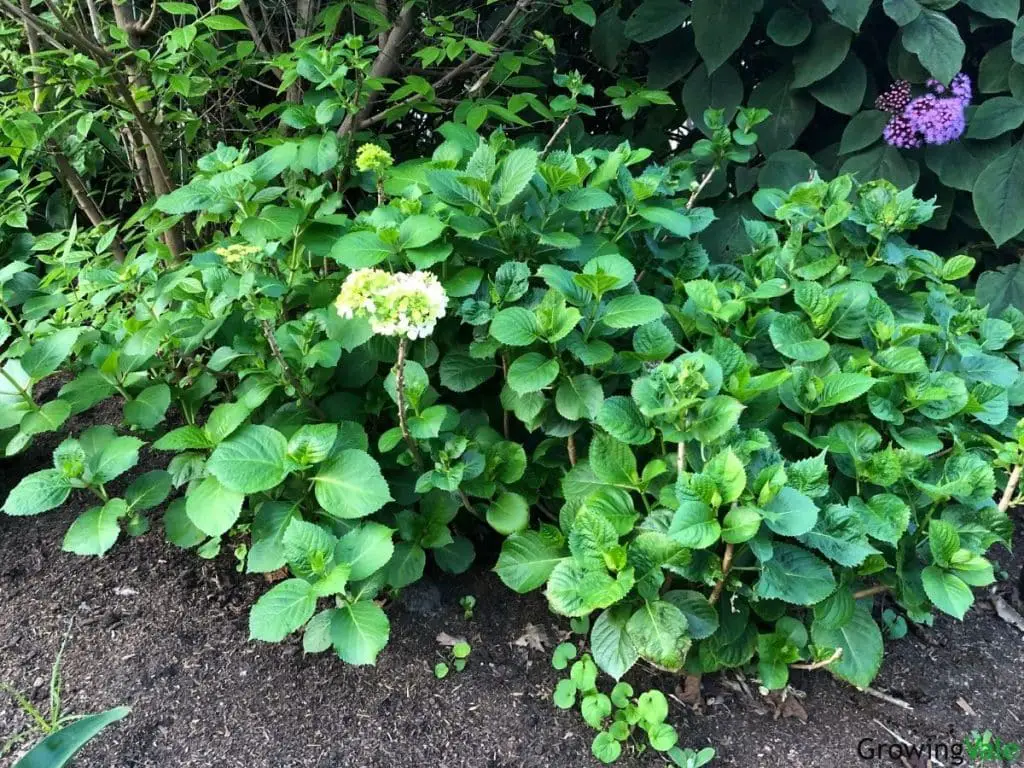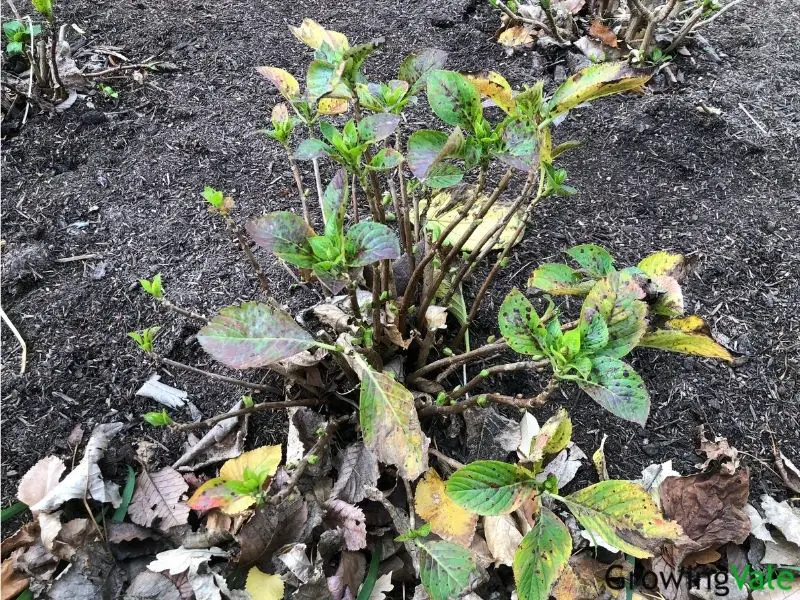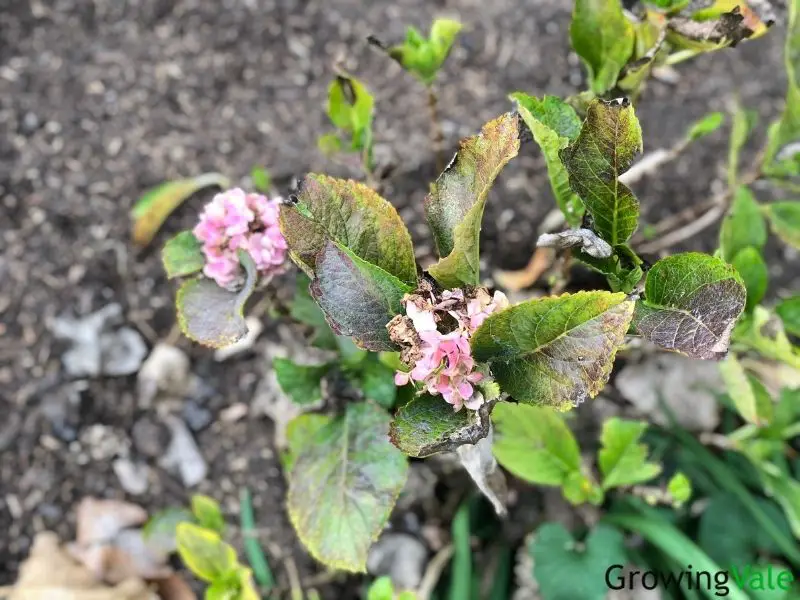In the vast majority of cases, discoloration on the leaves of your hydrangea plant will not cause any long-lasting or serious damage to your shrub. Usually, the flowers are unaffected.
However, because leaf blemish is not attractive and is also a sign that all is not well with your shrub, it is advisable to consider the cause. You can then look at the prevention of future hydrangea leaf problems or curing an existing condition.
What is Causing the Damage to the Hydrangea Foliage
There are two main causes of brown spots on hydrangea leaves, bacteria or fungus.
Of these, a fungal disease is more likely to be the cause of hydrangea leaves turning brown.
Fungal Disease
Cercospora Leaf Spot
This is a disease that affects hydrangea leaves and causes brown spots on the foliage at the base of the plant. The spots are small and sometimes have a purplish tinge.
Anthracnose
Anthracnose is a different fungus, which results in larger brown spots which have a white or light-colored center. If a hydrangea bush has been infected by this type of fungus, the spotting may also occur on the petals of the flowers. This is the easiest way of knowing that the damage has been caused by the anthracnose fungus.
Anthracnose fungus can, sometimes, kill hydrangeas.
Bacterial Disease
Like cercospora, a hydrangea that is affected by a bacterium will develop leaf spots on the lower leaves nearest the ground.
The leaf spots will be purplish or red in color and will also run along the central veins of the leaves.

How to Deal with Hydrangea Leaf Spot
Although a chemical fungicide can be used, it is not usually necessary. In most cases, the damage caused to the leaves will not adversely affect the plant’s health, nor its ability to flower. The damage will only be cosmetic.
The other main problem with many chemical fungicides is that once the application has started, the treatment must be continued every ten days from the spring until mid-summer. Sometimes, depending on the weather conditions, treatment is even more frequent than this.
A more effective solution is to keep the base of the plant free from plant debris. Remove old leaves, dead or decaying wood, and the previous year’s dried flower heads.
Improve the circulation of air around the base of the hydrangea shrub by cutting out old stems from the center of the plant once a year.
Some fungal diseases can spread by droplets of water. Although you can’t direct the rainfall, you can make sure that when watering your plant, you water at the base. Avoid watering from above as this will result in splashing on the leaves and flowers.
If leaf spot has taken hold, it is advisable to cut off, remove and burn any infected leaves unless by doing so, you would spoil the overall look of the shrub. These infected leaves should not be left in contact with the hydrangea, nor added to a compost heap. This can help to reduce the spread of the fungus spores to other non-infected parts of the plant.
It is possible to use natural remedies to treat hydrangea leaf spot, such as using a spray made up of seaweed extract, garlic oil, or even composted tea.
Yellow Leaves – an Indication of Root Damage
If the leaves on your hydrangea plant have turned yellow, brown, or fallen off, then this may indicate that a more severe problem has affected its roots.
No hydrangea plant will tolerate having its roots left to sit in heavy, waterlogged soil for a prolonged period of time. Its roots will start to rot, causing the leaves to turn yellow, then brown. If left, the leaves will fall off and plant will quickly die.
A hydrangea that has only recently been planted or transplanted, is more likely to suffer from root damage. A new plant will not have had a chance to develop an established root system.
Similarly, if a hydrangea has not had sufficient water and its roots have been allowed to dry out, its roots can die. Again, this is more critical with a new plant that has not grown a robust root structure.

How to Treat Root Damage
Never be tempted to treat root damage with fertilizer! An application of hydrangea fertilizer to an already sick plant is even more likely to kill it. If over-fertilizing is the cause of your root damage, then give it a thorough watering to attempt to wash the fertilizer through and away from the plant’s roots. You then need to leave it for a few days, without watering it.
If the root damage has been caused by continued overwatering, or from an extended period of rain, you need to act fast. The best way to try to minimize the damage is to provide good drainage around the roots of the plant to allow the excess water to drain away from the base of the plant.
Heavy clay-like soil is not suitable for growing hydrangeas successfully. If planting in wet soil, you need to consider keeping your hydrangea bush in a pot or other container.
A hydrangea that has been left to dry out needs careful watering to restore it to good health. Resist the temptation to water, water, and water! Give the plant a good soaking, but then allow it to almost dry out before re-watering.
Leaf Wilt after a Hard Frost
After a hard frost, you may be shocked to find your hydrangea looks in a pitiful state! But you can be assured that a winter freeze will not harm your plant. It isn’t necessary to protect your hydrangea shrub from winter conditions.
That being said, an early autumn frost after a spell of high temperatures, or a late frost in the spring can cause damage to emerging flower buds and to new, tender growth. So if you have a severe frost predicted in the spring, find a piece of breathable fabric with which you can loosely cover the shrub. Plastic is not a good choice of material, as it leads to condensation which can freeze and can cause further damage.
This is really only practical if your hydrangea is relatively small; however, any protection that you can provide on the coldest side of the plant should help to protect the stems and flower buds. If you have a hydrangea growing in a pot, it may also be possible to move it indoors during the cold snap.
Learn more about diseases of hydrangeas and how to care for hydrangea shrubs.

